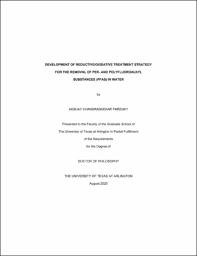
ATTENTION: The works hosted here are being migrated to a new repository that will consolidate resources, improve discoverability, and better show UTA's research impact on the global community. We will update authors as the migration progresses. Please see MavMatrix for more information.
Show simple item record
| dc.contributor.advisor | Choi, Hyeok | |
| dc.creator | Parenky, Akshay | |
| dc.date.accessioned | 2020-09-10T17:42:45Z | |
| dc.date.available | 2020-09-10T17:42:45Z | |
| dc.date.created | 2020-08 | |
| dc.date.issued | 2020-08-10 | |
| dc.date.submitted | August 2020 | |
| dc.identifier.uri | http://hdl.handle.net/10106/29418 | |
| dc.description.abstract | The detrimental health effects of halogenated compounds in humans has been well documented, and the frequent occurrence of per- and polyfluoroalkyl substances (PFAS) in the water environment is a recent global concern. Feasible and sensible treatment strategies are in dire need for environmental remediation and water treatment. Currently, efficient treatment is only obtained at a small scale and at a high energy cost.
This research is presented in three subsections, where decomposition of selected PFAS was evaluated under advanced oxidation techniques. The first study involved decomposition of a polyfluoroalkyl substance, 6:2 fluorotelomer sulfonate (6:2 FTS), in which 2 carbons of the alkyl chain are hydrogenated making the molecule more vulnerable to degradation. The 6:2 FTS was tested against some of the common oxidants such as persulfate (PS), peroxymonosulfate and hydrogen peroxide. Interestingly, 6:2 FTS was degraded by PS alone under ambient conditions. Several byproducts and fluoride release were observed and quantified. A decomposition pathway was proposed, and certain reaction intermediates were identified.
Upon achieving successful degradation of 6:2 FTS, a highly oxidized perfluorinated compound, perfluoroctanesulfonic acid (PFOS) was investigated. The absence of C-H bonds makes the molecule more resilient to conventional oxidation, hence a synergistic approach of using reduction combined with advanced oxidation was envisioned. This strategy involved the use of electrons generated by zero valent iron as the reductive source in combination with highly reactive radical species such as sulfate radical and hydroxyl radicals as the oxidizing species. This combination of oxidation and reduction was evaluated under several conditions by changing factors such as concentration, pH, and temperature. Significant removal of PFOS was observed in most cases but no transformation was observed. However, when this system was tested for perfluorooctanoic acid (PFOA), decomposition byproducts were observed consisting of short chain compounds demonstrating the potential for this treatment strategy.
Although decomposition of PFOA was achieved through the synergistic approach, the constraints of heat requirement reduce the practical applicability of the system. Since oxidants can be activated efficiently by transition metals, several different combinations of metal-oxidants were evaluated. Amongst these combinations, silver-PS was successful in decomposing a variety of carboxylic PFAS under ambient conditions without the use of any external energy source such as heat, ultra-violet or microwave. Significant byproduct and fluoride release were observed upon decomposition of selected PFAS. This system shows great potential for in situ application of PFAS remediation. The reaction mechanism for the system is complex and future studies should: i) investigate the role of silver and identify the reactive species responsible for the reaction, ii) identify an appropriate metal-oxidant pair capable of decomposing sulfonic PFAS, and iii) evaluate the efficacy of these systems for a wider range of PFAS. | |
| dc.format.mimetype | application/pdf | |
| dc.language.iso | en_US | |
| dc.subject | Per- and polyfluoroalkyl substances | |
| dc.subject | Advanced oxidation technologies | |
| dc.subject | Silver | |
| dc.subject | Persulfate | |
| dc.subject | Common oxidants | |
| dc.subject | Zero valent iron | |
| dc.subject | Room temperature decomposition | |
| dc.title | DEVELOPMENT OF REDUCTIVE/OXIDATIVE TREATMENT STRATEGY FOR THE REMOVAL OF PER- AND POLYFLUOROALKYL SUBSTANCES (PFAS) IN WATER | |
| dc.type | Thesis | |
| dc.degree.department | Civil Engineering | |
| dc.degree.name | Doctor of Philosophy in Civil Engineering | |
| dc.date.updated | 2020-09-10T17:42:46Z | |
| thesis.degree.department | Civil Engineering | |
| thesis.degree.grantor | The University of Texas at Arlington | |
| thesis.degree.level | Doctoral | |
| thesis.degree.name | Doctor of Philosophy in Civil Engineering | |
| dc.type.material | text | |
Files in this item
- Name:
- PARENKY-DISSERTATION-2020.pdf
- Size:
- 2.297Mb
- Format:
- PDF
This item appears in the following Collection(s)
Show simple item record


